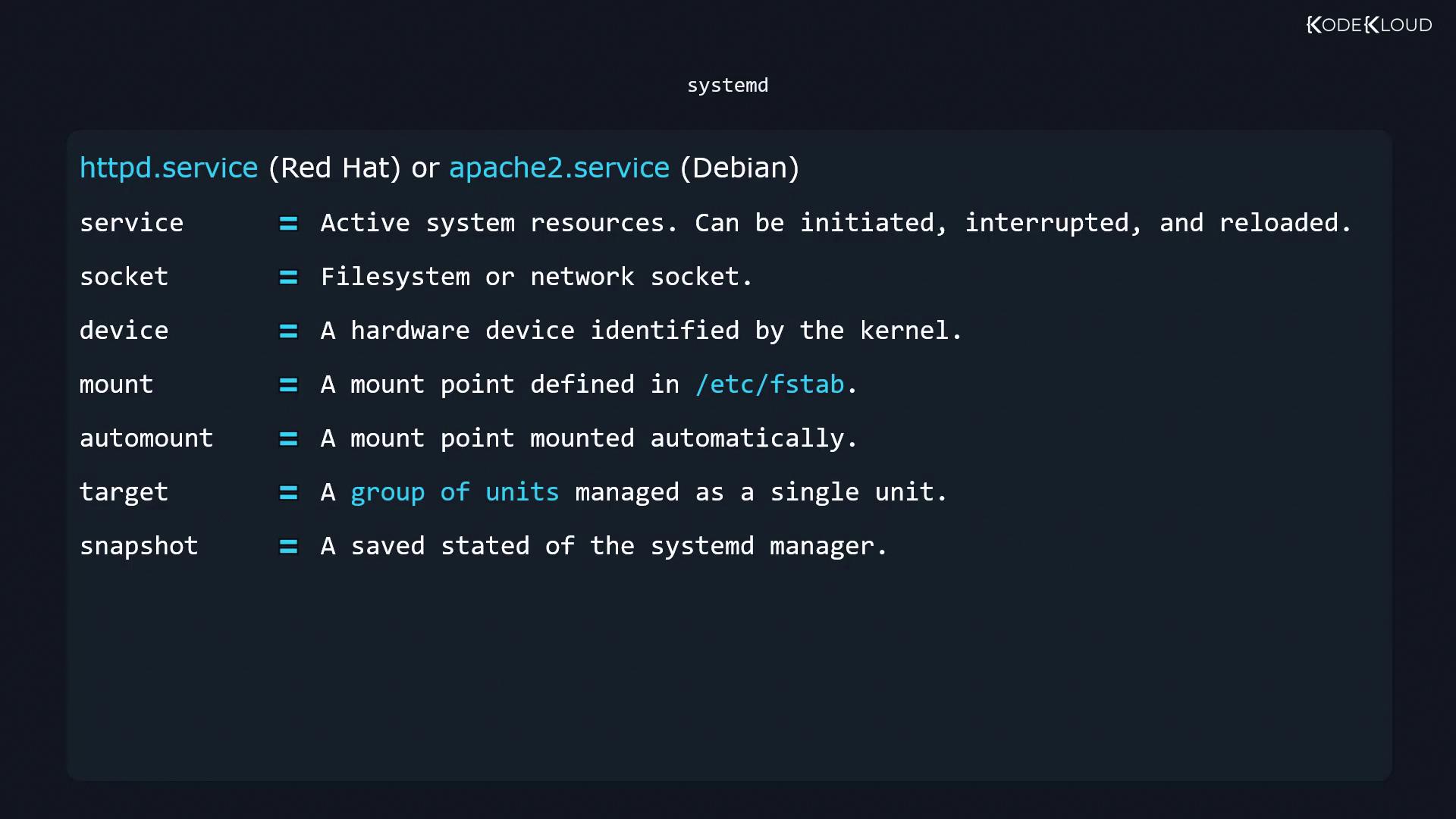Linux Professional Institute LPIC-1 Exam 101
System Architecture
Change Runlevels systemd
In this lesson, you’ll learn how to control system services and targets (runlevels) using systemd, the modern init system for Linux. Systemd manages resources through units, each identified by a name, type, and configuration file. For instance, the Apache HTTP server appears as httpd.service on RHEL-based distributions and apache2.service on Debian-based systems.
Understanding systemd Units
Systemd supports seven primary unit types:
| Unit Type | Description |
|---|---|
| service | Manages daemons and background services (e.g., nginx.service, httpd.service). |
| socket | Defines file or network sockets and activates a service when a connection arrives. |
| device | Represents a kernel-recognized hardware device via a matching udev rule. |
| mount | Describes a filesystem mount point (equivalent to an entry in /etc/fstab). |
| automount | Mounts filesystems on first access; pairs with a mount unit for configuration. |
| target | Groups units for collective management (analogous to SysVinit runlevels). |
| snapshot | Captures the current state of systemd’s unit manager (not available on all distributions). |

Managing Units with systemctl
The systemctl command is your primary interface to start, stop, reload, and query units. Replace unit.service with your target unit name.
Starting, Stopping, and Restarting Services
sudo systemctl start unit.service # Start the service
sudo systemctl stop unit.service # Stop the service
sudo systemctl restart unit.service # Restart the service
sudo systemctl status unit.service # Show status and recent logs
Checking Active State
systemctl is-active unit.service # Outputs 'active' or 'inactive'
Enabling and Disabling Services at Boot
sudo systemctl enable unit.service # Enable at boot
sudo systemctl disable unit.service # Disable at boot
systemctl is-enabled unit.service # Outputs 'enabled' or 'disabled'
Working with Targets (Runlevels)
Systemd targets correspond to traditional runlevels. For example, multi-user.target is like runlevel 3, while graphical.target maps to runlevel 5.
sudo systemctl isolate multi-user.target # Switch immediately to runlevel 3
sudo systemctl set-default multi-user.target # Persist default target across reboots
systemctl get-default # Display the current default target
Warning
Never set the default target to shutdown.target, as it will power off the system immediately after boot.
Listing Unit Files and Active Units
- All unit files and their boot-time enablement state:
systemctl list-unit-files systemctl list-unit-files --type=service systemctl list-unit-files --type=target - Currently active units in this session:
systemctl list-units systemctl list-units --type=service systemctl list-units --type=target
Power Management with systemctl
Systemd can handle suspend and hibernate when no other power manager is running:
sudo systemctl suspend # Enter low-power mode; RAM remains powered
sudo systemctl hibernate # Save RAM to disk, then power off
Note
Power-related settings live in /etc/systemd/logind.conf and any drop-in files under /etc/systemd/logind.conf.d/. For finer control over ACPI events (lid close, battery thresholds, etc.), consider using the acpid daemon.
Links and References
- systemctl Manual
- systemd Official Documentation
- Red Hat Enterprise Linux systemd Guide
- Debian systemd FAQ
Watch Video
Watch video content